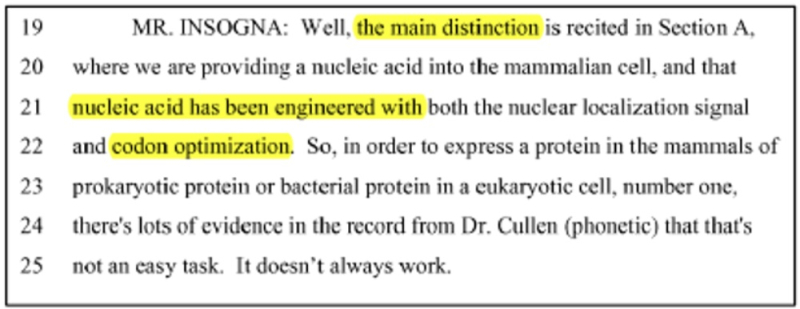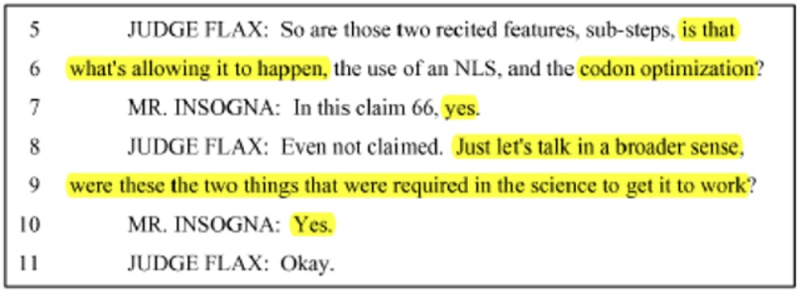On May 20th, Junior Party the University of California, Berkeley; the University of Vienna; and Emmanuelle Charpentier (collectively, "CVC") filed its Substantive Preliminary Motion No. 2 in Interference No. 106,127 (which names ToolGen as Senior Party), asking the Patent Trial and Appeal Board to deny ToolGen benefit of priority to U.S. provisional application No. 16/717,324, filed October 23, 2012, pursuant to 37 C.F.R. §§ 41.121(a)(1)(ii) and 41.208(a)(3) and Standing Order ¶ 208.4.1. The significance of the Board granting this motion would be that CVC would be Senior Party, with all the presumptions benefiting from Senior Party status.
CVC argues that the Board should deny ToolGen priority benefit to the '324 application based on party admissions because this provisional application does not disclose an operative embodiment falling within the scope of the interference Count. Specifically, CVC argues that ToolGen in the prosecution of the '324 patent application leading to allowance (and declaration of this interference) had argued to the Patent Examiner (and PTAB) that "a codon-optimized Cas9 nucleic acid is required for CRISPR-Cas9 to function in eukaryotic cells" and that "a skilled artisan would have no idea what the outcome may be if one were to codon optimize a Cas9 nucleic acid." This position was consistent with the prokaryotic source of Cas9, and the Board and Examiner relied upon these arguments to find allowable claims in the '324 application (now claims designated as corresponding to the Count in this interference), CVC asserts. All such claims require use of a Cas9-encoding nucleic acid that is codon-optimized for expression in eukaryotic cells, and ToolGen added this limitation to the claims to overcome anticipation and obviousness rejections based on the prior art. But ToolGen's '324 application does not disclose a codon-optimized Cas9 nucleic acid, according to CVC, nor by ToolGen's own argument would the skilled worker be able to discern such a nucleic acid with any reasonable basis for expecting such an embodiment could be produced using the disclosure in the '324 application. Accordingly, CVC argues in its motion, ToolGen cannot in this interference renounce these arguments and rely on the priority date of the '324 patent to constitute a constructive reduction to practice for eukaryotic CRISPR-Cas9 embodiments falling within the scope of the interference Count. Thus, according to CVC, the Board should deny ToolGen priority benefit to the '324 application (and redeclare the interference naming CVC as Senior Party).
The brief is replete with examples from the '324 prosecution history (CVC characterizing these statements as "unambiguous" and "unequivocal"), including this colloquy from oral argument before the Board in an appeal during that prosecution:

* * *
and

ToolGen even went so far as to represent to the Office that CRISPR-Cas9 would not function in eukaryotic cells without codon optimization, CVC argues. In summary, CVC asserts ToolGen took the position:
ToolGen's position during prosecution is clear and unmistakable: its invention required a codon-optimized Cas9 nucleic acid, codon-optimizing the Cas9 nucleic acid was unpredictable, and one would have "no idea" of the outcome of codon optimizing [emphasis in brief].
and should not now be permitted to disavow it. (And the fact that the Board instituted this interference having a Count comprising in the alternative a CVC claim that does not require a codon-optimized nucleic acid encoding Cas9 does not change the argument, CVC asserts.)
CVC concedes that, in fact, codon optimization was known in the art as of the '324 application's filing date. But ToolGen's admissions should preclude this fact from overcoming the estoppel-creating admissions, CVC tells the Board in their brief. The legal basis for CVC's argument is based on judicial estoppel (citing Zedner v. United States, 547 U.S. 489 (2006)), and the effect of party admissions on positions taken in a later proceeding before the Board. Citing Springs Window Fashions LP v. Novo Industries, L.P., 323 F.3d 989, 995 (Fed. Cir. 2003), CVC argues that "[t]he public notice function of a patent and its prosecution history requires that a patentee be held to what he declares during the prosecution of his patent" (emphasis in brief); accord, Louis v. Okada, 59 U.S.P.Q.2d 1073, 1075 (B.P.A.I. 2001) (precedential), wherein the Board denied a motion to amend the Count to "better align with [a party's] best proofs" because the party had relied on the element in question to overcome a prior art-based rejection. In addition to Zedner, CVC cites New Hampshire v. Maine, 532 U.S. 742, 742 (2001), in support of the application of the "equitable doctrine of judicial estoppel" here, and Wilson v. Martin, 789 Fed. Appx. 861, 872 (Fed. Cir. 2019), for the Board having the authority to apply the doctrine. CVC bases its argument on the inconsistency of a finding that there is any basis of support in the '324 for providing a constructive reduction to practice in this interference in the absence of disclosure of codon-optimized CAS9-encoding nucleic acid with ToolGen's consistent position to the contrary during prosecution (as evidenced by citations to the prosecution history throughout the brief). And ToolGen would receive an unfair advantage should the Board rule to the contrary, CVC asserts (that advantage including ToolGen being Senior Party instead of CVC in this interference).
One factual basis for CVC's argument is that while ToolGen's asserted codon optimization was necessary to produce a Cas9 protein functional in a eukaryotic cell, and the undisputed fact that codon optimization was known in the art at the '324 application's filing date, which embodiment of a codon-optimized nucleic acid encoding Cas9 was not disclosed therein, and not only did the '324 not provide any nucleic acid encoding Cas9 from any species other than its native one (S. pyogenes), the application did not even disclose a codon-optimization table (for a feature ToolGen argued was necessary to achieve operative eukaryotic CRISPR embodiments). CVC also proffered expert testimony regarding the significance of these deficiencies, including the existence at the priority date of several codon-usage tables in the art having different frequencies for 12 of the 20 naturally occurring amino acids (and thus there being no consensus in the art as to which codons would be optimal for eukaryotic cell expression of Cas9).
And the fact that ToolGen's specification purportedly shows successful reduction to practice of CRISPR-Cas9 mediated gene editing in eukaryotic cells does not cure the lack of written description of a codon-optimized Cas9 according to CVC, citing In re Alonso, 545 F.3d 1015, 1021 (Fed. Cir. 2008), for the principle that "[p]roof of a reduction to practice, absent an adequate description in the specification of what is reduced to practice, does not serve to describe or identify the invention for purposes of the written description requirement" (emphasis added).
CVC is careful to argue that "of course" ToolGen's deficiencies in no way can be attributed to CVC, because CVC never argued the absolute need for codon optimization for nucleic acids encoding Cas9 for operable eukaryotic embodiments of CRISPR, nor did CVC argue that codon optimization was either essential nor unpredictable (indeed, CVC asserts its consistent argument that by May 2012 codon optimization was "a routine technique such that skilled artisans would have expected to express a functional Cas9 protein from a codon-optimized nucleic acid in eukaryotic cells").
CVC asserts that these arguments are sufficient for the Board to deny priority benefit to ToolGen of the '324 application.